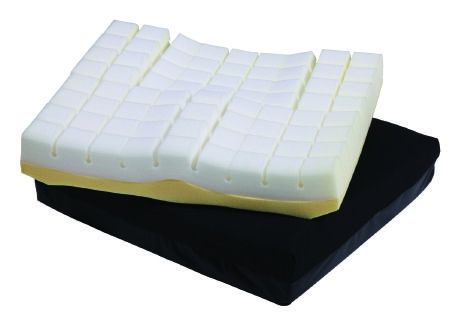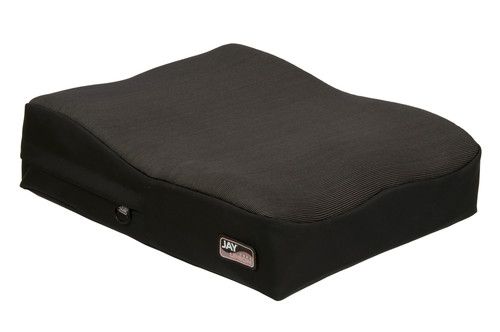 Written by Hulet Smith, OT
Written by Hulet Smith, OT
For individuals who spend all or part of their day in a wheelchair, the right seating cushion is a necessary aid for reasons of both comfort and health!
Foam wheelchair cushions make it possible to sit comfortably for long periods, and help the user maintain a balanced, proper seated position that doesn’t cause strain on muscles or joints.
For long-term wheelchair users, skin protection and correct posture are of utmost importance. These users need a cushion that will protect against pelvic rotation, as well as prevent skin shearing (tearing of skin when shifting position), both of which lead to a tremendously uncomfortable experience.
A foam wheelchair cushion tends to offer a firmer seating surface, making it an excellent choice for overall support and positioning.
Many foam cushions include a gel insert that provides an extra degree of softness and ease. Gel/foam cushion combos are the best of both worlds: supportive and pliable, moving with the user while also keeping them held securely in place. Gel/foam cushions are highly recommended for users with advanced stages of skin breakdown, as well as for bariatric users.
Finally, the cover that comes with a standard foam wheelchair cushion is typically made of soft, flexible fabric amd helps prevent shear and resist body heat buildup.
.jpg)
The overall structure of each foam wheelchair cushion will vary, depending upon the particular positioning challenges it’s designed to address! Fortunately, finding out what a cushion is made to do is as simple as reading it’s list of features and benefits.
When reading about a cushion, look for the following positioning features and keywords:
This feature cushions the upper thighs and protects the backs of the knees. A cushion with a waterfall contour will have a downward-curving front, rather than a front with a 90 degree right angle.
This cutout takes pressure off the tailbone (coccyx) and prevents a buildup of pressure on the lower spine.
Similar to the pommel on a riding saddle, this feature encourages leg abduction and prevents the legs from falling apart or knocking together.
Prevents forward leaning and slumping, which can lead to spine curvature.
Keeps hips from sliding forward and prevents users from slipping out of the wheelchair.
Cushions with contours, unless further specified, generally have a more defined seat shape, and cradle the user for additional comfort overall.
Other considerations to make include:
An all-foam cushion is a sound choice for someone at low risk of developing pressure sores. However, foam is designed first and foremost for support, and often works better as a cushion base or in combination with other more shapeable materials such as gel or memory foam.
For individuals at high risk of skin breakdown (or users already living with pressure ulcers), a foam cushion with a gel insert or gel topping should be considered, rather than a solid foam cushion. In order to provide enough protection and appropriate weight distribution, users will need a tool that moves with their body, and does more than simply cushion their sits bones.
Nearly all foam wheelchair cushions come with covers that offer varying degrees of defense against moisture. If you’re unsure about what to look for in a cover, pay attention to words like “water resistant” and “moisture repellant”.
Polyester or nylon covers offer moisture reduction, and can also reduce built-up body heat and accompanied perspiration. Polyester and nylon can also be easily wiped down when minor stains occur!
However, if incontinence is an ongoing issue, you’ll want to select a cover that is fully fluid-proof and is specifically designed to keep the cushion sealed and dry. Many of these covers are antimicrobial, too, and resist mold and mildew!
Positioning and health decisions aside, don’t forget that comfort is vital for a person who spends most of their day in a wheelchair! Much like walking and working in a tight pair of shoes, sitting on an uncomfortable cushion over the course of a day can be very difficult and lead to unnecessary pain.
The more cushioning the user desires, the thicker foam they’ll need. A gel insert and/or gel topper will give an individual the maximum possible amount of softness, and will conform to the user’s shape much better than a 100% foam cushion. (Keep reading for our top foam wheelchair cushion recommendations!)
When making the decision about which cushion is best suited to meet your physical needs, users should consider whether they need a standard size wheelchair cushion, or a cushion specifically designed to provide adequate support for heavier-bodied individuals.
Considerations should also include the level of thickness a foam cushion provides, and whether or not the model they are considering will give them the preferred amount of moldability. If you have your eye on a model that seems a little low on foam depth, integrating a gel cushion topper could make a world of difference.
These two factors work hand-in-hand, and should be considered together when making a choice about a foam wheelchair cushion.
Where a gel cushion is resilient - gel is designed to redistribute quickly once the user leaves the chair - foam does not behave in this manner. Rather, it tends to compress and slowly flatten out over time, much like an overused bed pillow would.
Foam cushions normally range from 1 - 4” in thickness, although not every cushion style is available in all four thickness increments. The heavier the user, the quicker the cushion compresses. Therefore, a 100% foam cushion (one without gel inserts or overlays) is a better choice for users who do not weigh more than 250 pounds. Many foam cushions will state specific weight limits to help guide you in this area.
Persons weighing 250 pounds or less with low risk of developing pressure sores or skin breakdown are the ideal users of foam wheelchair cushions. Additionally, a foam cushion may be better for a user who is partially mobile - meaning, they can leave a wheelchair to ambulate independently for a portion of the day.
Yes - in part! Medicare Part B will pay for up to 80% of the cost of a wheelchair cushion, and then you are required to cover the remaining 20%.
That said, Medicare does have some very specific requirements for coverage, it’s important to be aware of what they are!
Users must have a doctor’s prescription for the cushion they want to order, and the perscribing doctor must be approved by Medicare to authorize a prescription. Additionally, the wheelchair cushion order must specify which type of cushion material you require (gel, foam, etc.), and authorize that you meet the criteria required for that specific type of cushion.
Gel cushions are considered necessary for skin protection, and as such, Medicare will only cover the cost of a gel cushion if the user either has a pressure ulcer or has had one in the past - and in an area where the body touches the wheelchair seat.
Medicare will also cover the cost if the user has impaired sensation (or no sensation) in the part of the body that comes in contact with the wheelchair seat. This should be due to one of the following conditions:
If the cushion is prescribed specifically for positioning needs, the user must have significant asymmetry of posture caused by one of these conditions:
Coverage may be given for a cushion that addresses both skin protection and positioning, if requirements for both conditions are met.
To avoid unexpected costs and unwanted surprises, we highly recommend checking with your individual insurance company prior to purchasing any wheelchair cushion!
If covered, most insurance companies will replace your wheelchair cushion every three years. Checking with your insurance company before purchasing is always the best idea.

The Geo-Matt Contour wheelchair cushion was rated top choice by our staff for its affordability and advanced technology. The cushion is constructed of 72 cross-cut foam cells that move independently and distribute heat to provide comfort at a level not frequently seen in foam cushions. Even better: the accompanying cover is durable, incontinence-proof, and stretches comfortably to cradle the user.
We awarded the Geo-Matt Contour as the best foam wheelchair cushion overall, and you can read why here!

The Curve Cushion combines several of the positioning features mentioned earlier: leg abductors, thigh separators, and an anti-thrust shelf. Reviewers of the Curve Cushion made special mention of its superior comfort and support! You can read more about what makes the Curve a budget friendly option in this article!

The Jay Union has three key features that make all the difference for users with advanced positioning needs: a pommel, a coccyx cutout, and a waterfall front. Features aside, this cushion is also super soft to the touch, thanks to both a gel insert and a topper of double-layered memory foam.
You can read more about the Jay Union and find out why it won the award of Most Advanced Foam Wheelchair Cushion here!
Keep reading with our article The 5 Best Foam Wheelchair Cushions, and watch more product reviews at Rehabmart’s YouTube Channel!
To see our full selection of high-quality foam wheelchair cushions, visit RehabMart's catalog page.

Co-founder/CEO of Rehabmart, Pediatric Occupational Therapist, husband, and father. Passionate about connecting special needs kids with superb nutrition, sensory integration, and complementary health strategies. Excited about Rehabmart's mission to become the premier online educational platform which empowers caregivers by spotlighting innovative devices and interventions to achieve optimal patient response and recovery.